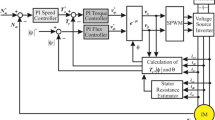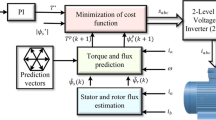Abstract
In this paper, an integral-proportional (IP) controller is employed in speed loop control in direct torque control (DTC) of a doubly fed induction motor (DFIM). Using IP parameters obtained from classical tuning methods, such as pole placement method, Ziegler–Nichols, etc., has disadvantages like high undershoot and overshoot, slow settling time, etc. To overcome the drawbacks of the classical methods, a new approach in which the IP controller parameters are tuned by rooted tree optimization (RTO) algorithm minimizing a multi-objective function is presented. The proposed algorithm has been verified and tested in control system with a PID controller. It presents improvement in performance response of various processes of different order compared with techniques such as Ziegler–Nichols, Kitamori’s, Fuzzy-PID and Iterative Feedback Tuning. In addition, simulation results of direct torque control response of a DFIM with an IP controller designed using the RTO algorithm minimizing a multi-objective function show its effectiveness and better performance in speed response. Robustness test against parameter sensitivity for the proposed DTC-DFIM-RTO is verified under stator resistance variation.




























Similar content being viewed by others
References
Yu K, Tang P (2018) Novel Equivalent Circuit Model and Theoretical Analysis of Doubly Fed Machine. IEEE Trans Energy Convers 34:1073–1081
El Ouanjli N, Derouich A, El Ghzizal A, Chebabhi A, Taoussi M (2017) A comparative study between FOC and DTC control of the Doubly Fed Induction Motor (DFIM). In: International conference on electrical engineering and information technology. IEEE, pp 1–6
BonnetFrancois F, Vidal P-E, Pietrzak-David M (2007) Dual direct torque control of doubly fed induction machine. IEEE Trans Indu Electro 54(5):2482–2490
Babouri R, Aouzellag D, Ghedamsi K (2013) Introduction of doubly fed induction machine in an electric vehicle. Ener Procedia 36:1076–1084
Jain JK, Ghosh S, Maity S, Dworak P (2017) PI controller design for indirect vector controlled induction motor: a decoupling approach. ISA Trans 70:378–388
Takahashi I, Ohmori Y (1989) High-performance direct torque control of an induction motor. IEEE Trans Ind Appl 25(2):257–264
Zemmit A, Messalti S, Harrag A (2017) A new improved DTC of doubly fed induction machine using GA-based PI controller. Ain Shams Eng J 9:1877–1885
Kumsuwan Y, Premrudeepreechacharn S, Toliyat HA (2008) Modified direct torque control method for induction motor drives based on amplitude and angle control of stator flux. Electric Power Syst Res 78(10):1712–1718
Gadoue SM, Giaouris D, Finch J (2009) Artificial intelligence-based speed control of DTC induction motor drives—a comparative study. Electric Power Syst Res 79(1):210–219
Sarasola I, Poza J, Rodriguez MA, Abad G (2011) Direct torque control design and experimental evaluation for the brushless doubly fed machine. Energy Convers Manag 52(2):1226–1234
Carmeli M, Mauri M (2011) Direct torque control as variable structure control: Existence conditions verification and analysis. Electric Power Syst Res 81(6):1188–1196
Abdelli R, Rekioua D, Rekioua T (2011) Performances improvements and torque ripple minimization for VSI fed induction machine with direct control torque. ISA Trans 50(2):213–219
Lazim MT, Al-khishali MJ, Al-Shawi AI (2011) Space vector modulation direct torque speed control of induction motor. Proc Comput Sci 5:505–512
Orlowska-Kowalska T, Tarchala G, Dybkowski M (2014) Sliding-mode direct torque control and sliding-mode observer with a magnetizing reactance estimator for the field-weakening of the induction motor drive. Math Comput Simul 98:31–45
Ziegler JG, Nichols NB (1942) Optimum settings for automatic controllers. Trans ASME 64(11):759–765
Kitamori T (1979) A method of control system design based upon partial knowledge about controlled processes. Trans Soc Inst Control Eng 15(4):549–555
Zhao Z-Y, Tomizuka M, Isaka S (1993) Fuzzy gain scheduling of PID controllers. IEEE Trans Syst Man Cyber 23(5):1392–1398
Lequin O, Gevers M, Mossberg M, Bosmans E, Triest L (2003) Iterative feedback tuning of PID parameters: comparison with classical tuning rules. Control Eng Pract 11(9):1023–1033
Chaouch S, Abdou L, Alaoui LC, Drid S (2016) Optimized torque control via backstepping using genetic algorithm of induction motor. Automatika 57(2):379–386
Mesloub H, Benchouia M, Goléa A, Goléa N, Benbouzid M (2017) A comparative experimental study of direct torque control based on adaptive fuzzy logic controller and particle swarm optimization algorithms of a permanent magnet synchronous motor. Int J Adv Manuf Technol 90(1–4):59–72
Hannan M, Ali JA, Mohamed A, Hussain A (2017) Optimization techniques to enhance the performance of induction motor drives: a review. Renew Sustain Energy Rev 81:1611–1626
Kumar DS, Sree RP (2016) Tuning of IMC based PID controllers for integrating systems with time delay. ISA Trans 63:242–255
Juang Y-T, Chang Y-T, Huang C-P (2008) Design of fuzzy PID controllers using modified triangular membership functions. Info Sci 178(5):1325–1333
Padula F, Visioli A (2011) Tuning rules for optimal PID and fractional-order PID controllers. J Proc Control 21(1):69–81
Harrag A, Messalti S (2015) Variable step size modified P&O MPPT algorithm using GA-based hybrid offline/online PID controller. Renew Sustain Energy Rev 49:1247–1260
Srivastava S, Pandit V (2016) A PI/PID controller for time delay systems with desired closed loop time response and guaranteed gain and phase margins. J Proc Control 37:70–77
Anil C, Sree RP (2015) Tuning of PID controllers for integrating systems using direct synthesis method. ISA Trans 57:211–219
Moharam A, El-Hosseini MA, Ali HA (2016) Design of optimal PID controller using hybrid differential evolution and particle swarm optimization with an aging leader and challengers. Appl Soft Comput 38:727–737
Liem DT, Truong DQ, Ahn KK (2015) A torque estimator using online tuning grey fuzzy PID for applications to torque-sensorless control of DC motors. Mechatro 26:45–63
Ye Y, Yin C-B, Gong Y, Zhou J-J (2017) Position control of nonlinear hydraulic system using an improved PSO based PID controller. Mech Syst Sign Proc 83:241–259
Lu K, Zhou W, Zeng G, Du W (2018) Design of PID controller based on a self-adaptive state-space predictive functional control using extremal optimization method. J Frankl Inst 355(5):2197–2220
Labbi Y, Attous DB, Gabbar HA, Mahdad B, Zidan A (2016) A new rooted tree optimization algorithm for economic dispatch with valve-point effect. Int Electr Power Energy Syst 79:298–311
Sannigrahi S, Ghatak SR, Acharjee P (2019) Fuzzy logic–based rooted tree optimization algorithm for strategic incorporation of DG and DSTATCOM. Int Trans Electr Ener Syst 29(8):e12031
Wadood A, Gholami Farkoush S, Khurshaid T, Kim C-H, Yu J, Geem ZW et al (2018) An optimized protection coordination scheme for the optimal coordination of overcurrent relays using a nature-inspired root tree algorithm. Appl Sci 8(9):1664
Sannigrahi S, Ghatak SR, Acharjee P (2018) Optimal planning of distribution network with DSTATCOM and WTDG using RTO technique. In: International power electronics, drives, and energy systems (PEDES) conference. IEEE, pp 1–6
Benamor A, Benchouia M, Srairi K, Benbouzid M (2019) A new rooted tree optimization algorithm for indirect power control of wind turbine based on a doubly-fed induction generator. ISA Trans 88:296–306
Benamor A, Benchouia M, Srairi K, Benbouzid M (2019) A novel rooted tree optimization apply in the high order sliding mode control using super-twisting algorithm based on DTC scheme for DFIG. Int J Electr Power Energy Syst 108:293–302
Cui Y, Geng Z, Zhu Q, Han Y (2017) Multi-objective optimization methods and application in energy saving. Energy 125:681–704
El-Samahy AA, Shamseldin MA (2018) Brushless DC motor tracking control using self-tuning fuzzy PID control and model reference adaptive control. Ain Shams Eng J 9(3):341–352
Ben Jabeur C, Seddik H (2020) Design of a PID optimized neural networks and PD fuzzy logic controllers for a two-wheeled mobile robot. Asian J Control 23:23–41
Kumar NS, Gokulakrishnan J (2011) Impact of FACTS controllers on the stability of power systems connected with doubly fed induction generators. Int J Electr Power Ene Syst 33(5):1172–1184
Maciejewski P, Iwanski G (2017) Direct torque control for autonomous doubly fed induction machine based DC generator. In: 2017 twelfth international conference on ecological vehicles and renewable energies (EVER). IEEE, pp 1–6
Takahashi I, Noguchi T (1986) A new quick-response and high-efficiency control strategy of an induction motor. IEEE Trans Ind Appl 5:820–827
Boudana D, Nezli L, Tlemçani A, Mahmoudi M, Tadjine M (2012) Robust DTC based on adaptive fuzzy control of double star synchronous machine drive with fixed switching frequency. J Electr Eng 63(3):133–143
Do TD, Choi HH, Jung J-W (2015) Nonlinear optimal DTC design and stability analysis for interior permanent magnet synchronous motor drives. IEEE/ASME Trans Mechatron 20(6):2716–2725
Verma A, Singh B, Yadav D (2014) Investigation of ANN tuned PI speed controller of a modified DTC induction motor drive. In: 2014 IEEE international conference on power electronics, drives and energy systems (PEDES). IEEE, pp 1–6
Sudheer H, Kodad S, Sarvesh B (2017) Improvements in direct torque control of induction motor for wide range of speed operation using fuzzy logic. J Electri Syst Inf Technol 5:813–828
Soufi Y, Bahi T, Lekhchine S, Dib D (2013) Performance analysis of DFIM fed by matrix converter and multi level inverter. Energy Conv Manag 72:187–193
Sreekumar T, Jiji K (2012) Comparison of proportional-integral (PI) and integral-proportional (IP) controllers for speed control in vector controlled induction motor drive. In: 2012 2nd international conference on power, control and embedded systems. IEEE, pp 1–6
Hwang C, Cheng Y-C (2006) A numerical algorithm for stability testing of fractional delay systems. Automatica 42(5):825–831
Acknowledgements
The authors would like to acknowledge support from Directorate General for Scientific Research and Technological Development (DGRSDT), Ministry of Higher Education and Scientific Research—Algeria.
Author information
Authors and Affiliations
Corresponding author
Additional information
Publisher's Note
Springer Nature remains neutral with regard to jurisdictional claims in published maps and institutional affiliations.
Appendices
Appendix 1: DFIM Parameters
Rated values 4 kW, 220/380 V, 1440 rpm Rated parameters Rs = 1.2 Ω Rr = 1.8 Ω Ls = 0.1554 H Lr = 0. 1568 H M = 0.15 H P = 2 Mechanical constants J = 0.2 kg m2 f = 0.0 N m s/rad |
Appendix 2: Nomenclature
DFIM
Vsα, Vsβ | Stator \(\alpha , \beta \) frame voltages |
Vrα, Vrβ | Rotor \(\alpha , \beta \) frame voltages |
isα, isβ | Stator \(\alpha , \beta \) frame currents |
irα, irβ | Rotor \(\alpha , \beta \) frame currents |
φsα, φsβ | Stator \(\alpha , \beta \) frame fluxes |
φrα, φrβ | Rotor \(\alpha , \beta \) frame fluxes |
Rsα, Rr | Stator and rotor resistances |
Lsα, Lr | Stator and rotor inductances |
M | Mutual inductance |
\(\sigma \) | Leakage factor |
Ts, Tr | Stator and rotor time-constant |
\(\Omega \) r | Rotor speed |
T e | Electromagnetic torque |
T L | Load torque |
J | Moment of inertia |
f | Friction coefficient |
p | number of pole pairs |
ω r | Rotor angular speed |
RTO
x new | New candidate |
x best | Best solution |
k | Candidate number |
iter | Iteration |
N | Population scale |
upper | Upper limit |
randn | Normal random number between [− 1, 1] |
rand | Number between [0, 1] |
R n | Rate of the random root |
R r | Rate of the random root |
R c | Rate of the continuous root |
Acronyms
DFIM | Doubly Fed Induction Machine/Motor |
DTC | Direct Torque Control |
FOC | Field Oriented Control |
IP | Integral Proportional |
RTO | Rooted Tree Optimization |
VC | Vector Control |
2D/ 3D | Two / Three-dimensional |
Rights and permissions
About this article
Cite this article
Bekakra, Y., Labbi, Y., Ben Attous, D. et al. Rooted Tree Optimization Algorithm to Improve DTC Response of DFIM. J. Electr. Eng. Technol. 16, 2463–2483 (2021). https://doi.org/10.1007/s42835-021-00796-4
Received:
Revised:
Accepted:
Published:
Issue Date:
DOI: https://doi.org/10.1007/s42835-021-00796-4




